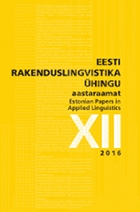Juhiste esitamine haldusaktides
Presenting instructions in administrative acts
Author(s): Riina ReinsaluSubject(s): Theoretical Linguistics, Lexis, Sociolinguistics
Published by: Eesti Rakenduslingvistika Ühing (ERÜ)
Keywords: text type; genre; administrative text; Estonian
Summary/Abstract: Local governments employ administrative acts for managing their own activities as well as those of other offices, businesses, private persons, etc. In order for an administrative act to best fulfil its purpose, a suitable textual strategy, covering both structural and linguistic choices, must be selected. No language user is entirely free in making such choices, but rather proceeds to a greater or lesser degree from examples set by previous texts, i.e. from conventions of genre and of the wider culture. The purpose of this paper is to determine what kinds of textual strategies and devices (including text types) are employed in orders, decisions, and directives for the purpose of achieving a genre-specific goal. Since the law specifies the issuer of the act, their sphere of competence, and the conditions for the issuance of the act, it can be presumed that some of the genre-specific characteristics are related to extra-linguistic factors. This paper focuses on the general and sentence structure of administrative acts, in order to determine whether such acts can be regarded as a distinct genre based on linguistic properties as well. The administrative acts under consideration have a structure as standardised by the corresponding domain. In 64% of the administrative acts, background information (reasoning, as well as references to legislation) is syntactically connected to the conclusion. As such, the content is conveyed in the form of declarative speech acts: the issuer of the act describes their own activity (e.g. X issues an order, X decides + da-infinitive), rather than giving out instructions. However, in 26% of administrative acts there is no syntactic connection between background information and the conclusion, for which reason the conclusion, constructed from da-infinitives, takes the form of instructions. Consequently, the micro-level of administrative acts presents a mixture of descriptive and instructive text types , whereas on the macrolevel the administrative acts here examined represent only the instructive text type. Although directives are more varied than orders and decisions (e.g. directives include fewer references to the reasons for the issuance of the act and to legislation, and such references are usually syntactically unconnected to the conclusion), the classification of orders, decisions, and directives into distinct administrative acts is primarily based on extra-linguistic (substantial) characteristics. For this reason, on the basis of their use of language they can be regarded as a single genre, a genre of administrative instructions.
Journal: Eesti Rakenduslingvistika Ühingu aastaraamat
- Issue Year: 2016
- Issue No: 12
- Page Range: 219-236
- Page Count: 18
- Language: Estonian

